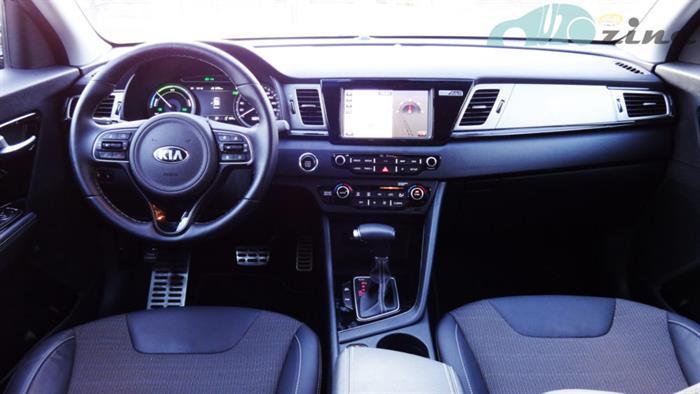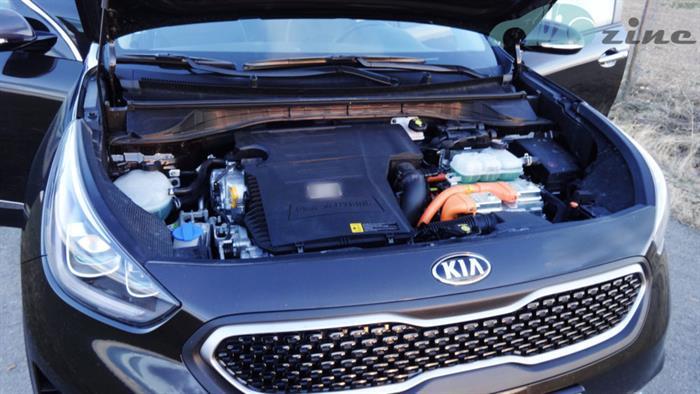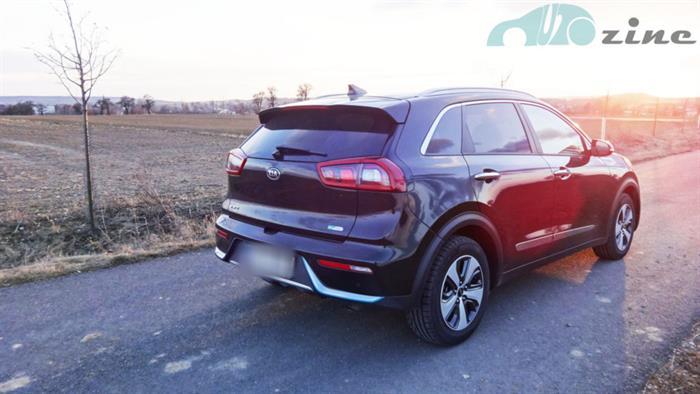The Niro is the current representative of crossovers from the Kia brand portfolio. Another representative of this category within the brand is the Kia Soul. However, in the context of these two models, Niro offers you a much calmer and more settled look.
The Plug-in Hybrid Niro made it to our editorial test. Kia thus responds to the offer of the Hyundai concern brand, which also offers its Ioniq model with a classic hybrid, plug-in hybrid or purely electric drive.
The Niro is already offered as a hybrid, the current novelty is a plug-in hybrid version, and an electric version is already expected.
EXTERIOR
 The external appearance of the Niro seems very neutral. At first glance, it does not evoke any positive or negative emotion in you.
The external appearance of the Niro seems very neutral. At first glance, it does not evoke any positive or negative emotion in you.
It hardly shows its affiliation to an ecologically minded car. You will only know that it is a plug-in hybrid from the individual discreet details and, of course, from the markings on the rear hood.
The front part of the car has significantly elongated headlights that reach deep into the front fenders. The car's mask and its shaping bear the typical features of the Kia brand.
The lower part of the bumper is equipped with a double line underlining the fog lights, and with its blue-chrome color combination it informs you that it belongs to the electrified drive.
The side profile of the car takes on the meaning of the crossover category, the classic front part transitions into a higher profile of the car roof, which is followed by a distinctly vertically oriented rear part. The side part is equipped with chrome edging of the upper part of the side glazing of the car, and then chrome plating of the lower parts of the doors.
The rear part, these are the calm horizontal proportions of the rear lights and a decent lollipop with brake lights, supplemented by a pair of already mentioned lines also found in the front part of the Niro.
In my opinion, the color of the tested version is behind the blandness of its external appearance. Niro in other color combinations has a much fresher impression.
INTERIOR
 The interior of the car is carried in the spirit of high-quality workmanship, which we have become accustomed to at the Kia brand recently.
The interior of the car is carried in the spirit of high-quality workmanship, which we have become accustomed to at the Kia brand recently.
Spaciousness is carried throughout the interior, you will find plenty of space in the front and back seats.
The color of the interior is in the spirit of a black-chrome combination. The dashboard of the car has a classic and decent impression. All controls are clearly located. All this is supported by its clear horizontal division.
Its central part has a touch screen, followed by separately located control elements of this display and air conditioning controls. The start x stop keyless start button is also a matter of course.
You control the on-board menu, navigation, radio or telephone with the eight-inch touchscreen. As part of the Plug-in Hybrid version, you are also informed about the energy flows in the hybrid system, the level of your driving style, fuel consumption, range on purely electric energy in the context of the navigation map, or the list of charging stations.
The navigation system has updated map data from HERE for a period of seven years.
The instrument cluster in front of the driver, next to the speedometer, also displays the classic power flow indicator for cars of this drive concept. The on-board computer display is then located in the middle, displaying other necessary information. The Niro can also be switched to sport mode, the trip computer readings disappear and the tachometer appears with a red background.
The center panel is equipped with a classic automatic transmission selector, which I would like to praise for its smooth operation. Then there are controls for choosing a purely electric versus hybrid drive, controls for heating the front seats or heating the multifunction steering wheel. The Niro is equipped with a foot brake, and there is enough space for two drink holders in the center panel.
The multifunctional steering wheel is clear and understated, following the example of the entire interior. Its center is classically round and very massive, as a result it looks very good.
The volume of the trunk, which is limited by the location of the batteries, has a volume of 324 liters. Compared to the version of the classic hybrid, there is a loss of 103 liters of luggage space due to the location of the larger battery.
ENGINE AND RIDE
 The Kia Niro Plug-in Hybrid is a combination of a gasoline four-cylinder atmospheric engine with a volume of 1.6 liters with a capacity of 103 hp and an electric motor with a capacity of 43 hp. The total output of the hybrid system is then 141 horsepower.
The Kia Niro Plug-in Hybrid is a combination of a gasoline four-cylinder atmospheric engine with a volume of 1.6 liters with a capacity of 103 hp and an electric motor with a capacity of 43 hp. The total output of the hybrid system is then 141 horsepower.
The plug-in hybrid shares its technology with the classic hybrid, it only has a battery with a higher capacity. Its capacity is 8.9 kWh (only 1.56 kWh in the hybrid version). The Niro's range on electric power alone is 55 electric kilometers.
The way the electric motor and gasoline engine work together depends on the state of charge of the batteries. When they are sufficiently charged, the Niro runs mainly on electric power until the electric motor is no longer powerful enough, after which the gasoline engine is automatically connected.
In hybrid mode, the use of the gasoline engine and the electric motor is ensured in the spirit of maximum economy.
The car's drivetrain is connected to a six-speed automatic dual-clutch transmission, which works excellently with a pair of engines and their individual connection. Of course, the gearbox shifts smoothly, smoothly.
Niro is not a racer, it is a car from a category that makes you think about driving. Energy recovery works well, so taking your foot off the gas in time plays a big role.
All of this is most evident in city traffic, where driving is often from traffic light to traffic light and here you can spend a lot of time with the engine off and driving on pure electric energy.
According to the manufacturer, the consumption of the Niro is 1.3 liters per 100 km. Real consumption is of course higher. The editorial test took place during a period when the night temperatures dropped well below freezing, so after starting the Niru, the gasoline engine runs for a relatively long time for the overall heating and heating of the interior. This is then significantly prescribed in consumption.
During the weekly test, fuel consumption was around 6.0 liters per hundred kilometers. This consumption was also significantly affected by highway traffic, which accounted for almost half of the total number of editorial kilometers driven. At highway speeds, there is not much room for recuperation itself, which is why Plug-in Hybrids recharge their batteries with the internal combustion engine, not recuperation, and this unfortunately also has a clear impact on consumption.
CONCLUSION
The Kia Niro in the Plug-in Hybrid version is a spacious car with a very decent appearance. Its ideal environment is a city, where you can use its electrical potential to the fullest.
A purely electric range can be enough for many people on their way to work. He will surely save some recuperation kilometers on the way and charge the car overnight at home again for the next day. Yes, it will certainly not be so rosy, the heating or the current need for acceleration will certainly start the gasoline engine, but still, cars of this drive concept are an interesting choice.
The vehicle also gives you a lot of freedom, because it normally works with a minimum of electricity, you simply refuel it at the nearest pump.
The basic Niro is very richly equipped, for an additional fee you can only have metallic paint or the Convenience package (with artificial leather upholstery or ventilated front seats). Its basic price is 974,980 CZK, which is unfortunately not enough.
The Kia Niro is a very practical car for everyday use. Its neutrality in external appearance will to some extent help your indecision when choosing a new car.

































